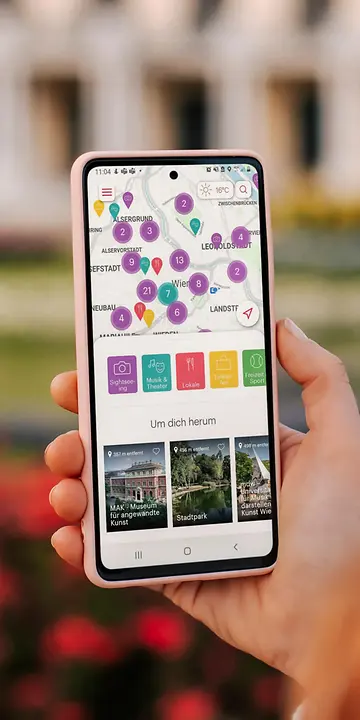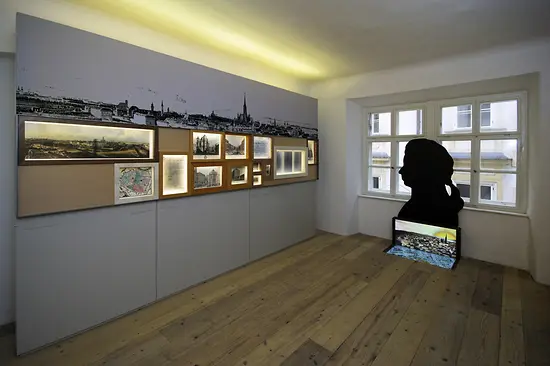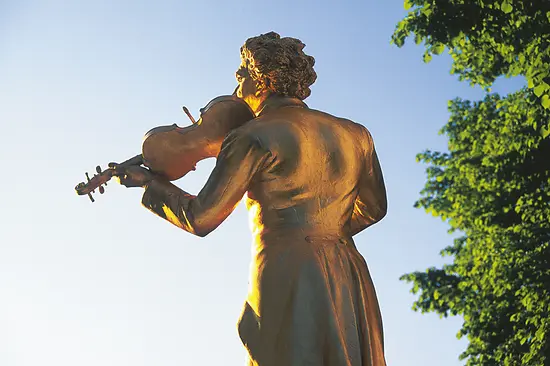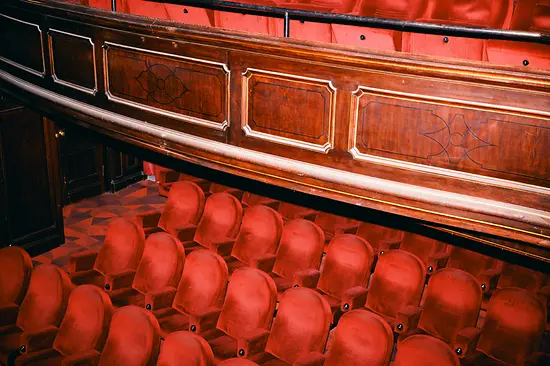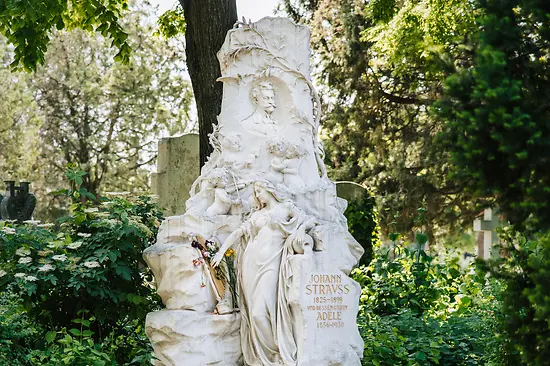House of Music
Take yourself on a musical journey in Vienna's singular Museum of Sound – in the historical palace of Archduke Karl in the old city center. Here you can look over the shoulders of the great composers of the past – from Strauss to Mozart – as they composed, meet the best musicians of the present and look into the future of digital music and virtual reality.
Four floors invite you into the world of sound and noise phenomena – every day until 10.00 pm. Music is not just for listening to: in the House of Music, visitors can also see, feel and create tones and sounds themselves, for instance in Sonotopia Lap & Universe, a virtual reality experience. Computer installations are your tour guides.
Installations and interaction
The interactive application Facing Mozart lets visitors bring to live a Mozart portrait, with the use of an application called "facetracking". Slip into his role and control his head movements and facial expressions ...
Another installation is NAMADEUS, which was created after Mozart's musical game KV 516f. The names are changed into an original Mozart interpretation. Here you can also find the fascinating, interactive Waltz Dice Game.
Display alternative text
Haus der Musik
In the case of the virtual conductor, the Vienna Philharmonic - or at least its video projection - obeys everyone who wants to try their hand at conducting. However, the professional musicians respond to an overly poor sense of rhythm with criticism. Among the music pieces to be chosen: The Blue Danube Waltz by Johann Strauss, which enchants its audience for 150 years.
Experience Music Step by Step: The fixed stairs at the beginning of the sound museum's musical tour therefore act as a piano with 13 movement-sensitive steps as keys, each illuminating the activated note on the wall panel.
Composer stars from Mozart to Strauss
An entire floor in the House of Music is dedicated to the great composers who created something completely new in Vienna – each of them in their own innovative way. Their holograms hover in the entrance lobby of the World of Great Masters.
Joseph Haydn, Wolfgang Amadeus Mozart and Ludwig van Beethoven are the three superstars of Viennese classical music. Haydn is regarded as the “inventor” of the string quartet; he penned 104 (!) symphonies. His parrot could whistle the anthem he wrote for Emperor Franz I (II) (the melody is the one used in today’s German national anthem). Mozart – a native of Salzburg – moved to Vienna. He was able to express his genius in the music capital of the world. Beethoven was another who chose to move to Vienna: He was originally from Bonn and relocated when he was 22 years old, then deciding to stay in Vienna. While living here he created several famous symphonies. He wrote one of the most famous when he was already completely deaf: the 9th Symphony.
The Liederfürst (Prince of Songs) Franz Schubert was at home in a completely different profession. He performed to small audiences. It took some serious persuasion for the modest artist to give his first concert. His expressive Lieder, meaning songs, are deeply moving.
Johann Strauss II brought the waltz to the world stage and wrote operettas, including the world-famous “Fledermaus”. He shaped the popular music of his time. All of Vienna danced to the sounds of the Strauss dynasty. His father (a fierce competitor) and his brothers Josef and Eduard were likewise composers. Johann Strauss was a pop star of his time, immensely successful and popular – quite simply the Waltz King. Legend has it that he cut the locks of hair he gave to his admirers from a poodle.
Gustav Mahler was not only a passionate composer, but also a conductor and director of the Vienna Court Opera. His visionary, pioneering approaches ushered in the era of modern music.
The Museum of the Vienna Philharmonic
The House of Music was home to the founder and first Kapellmeister (conductor) of the Vienna Philharmonic: Otto Nicolai (1810-1849). Making it a good place for the museum and historical archive of the world-famous orchestra, which are located on the first floor.
On display in the Hall of Mirrors are testimonies to the rich history of the orchestra, such as documents of awards and the batons of famous conductors. The decree of establishment of the Vienna Philharmonic can be found in the Nicolairaum . As can the program of the first philharmonic concert of 1842, the first photo of the orchestra from 1864 and photographs of Otto Nicolai, Georg and Joseph Hellmesberger and other people who were important for the foundation of the orchestra and in the first decades of its existence.
House of Music (Haus der Musik) The Sound Museum
1010 Vienna
-
Vienna City Card
-
Benefits of the Vienna City Card: -24%
Additional information on the offer:
Standard ticket price: 17€ / reduced ticket price: 13€
Available on site and at ticket.viennacitycard.at
-
-
Opening times
- daily, 10:00 - 22:00
-
24.12. 10a.m. - 6 p.m., 23.03. 10a.m. - 6p.m. (5p.m. last admission)
-
Accessibility
-
Main entrance
- no steps (Automatic sliding doors )
-
Side entrance
- no steps
-
Elevator available
-
Further information
- Seeing eye dogs allowed
- Wheelchair accessible restroom available.
-
Special offers for people with disabilities
Tours in sign language on request, as well as tours for blind and visually impaired people.
-
Comments
Access to all exhibition rooms and café: no steps (via elevator).
-
Main entrance









